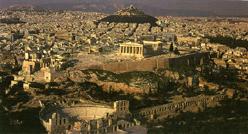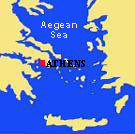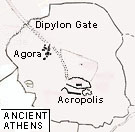


Bronze Age. The Acropolis was a fortified citadel, but Athens is not conspicuous in the Homeric poems, which indicate other important centres of Bronze Age Greece.
Early Iron Age (to 6th century BC). Athens was influential in developing the Geometric style of art in Greece, especially its figurative aspects. In the 6th century it was ruled by a 'tyrant' family, Peisistratos and his sons, in a period which saw considerable building and sculptural activity, especially on the Acropolis. By this time she was in control of the land of Attica and its many towns, including Eleusis. Her black figure pottery was widely exported, and red figure was invented in Athens about 525 BC. The Acropolis is the source of some of the finest archaic korai statues.
Classical period (5th/4th centuries): at the end of the 6th century the 'tyrants' were expelled and a form of democracy adopted. Having repulsed the Persians at Marathon in 490 the city was occupied by them in 480 and 479 BC. Thereafter Athens became the leader of a League of states committed to removing the Persians from all Greek lands, and Athens grew rich on contributions. Under Perikles the city embarked on ambitious architectural projects, such as the Parthenon and other temples, and Pheidias introduced an idealized realistic style in sculpture which typifies the 'classical'. At the end of the 5th century Athens was defeated by other Greek states in the Peloponnesian War. In the 4th century she was prominent in attempting to contain the growing influence of Macedonia, under politicians such as Demosthenes.
Hellenistic/Roman period (late 4th century BC-2nd century AD): as Macedon began to influence all activity in Greece, Athens was more a cultural than political force, although her democracy survived, even to some degree after Greece had been absorbed in the Roman empire. She became much favoured by various Roman emperors, especially Hadrian, who paid for new buildings and an Agora, and extended the formal city limits. Athens was a major centre for the production of Greek works to suit the Roman market, for which many of her classical statues were also copied.
Above left: Athens today. © Mario Bettella Licence Plate 11 UK 1007 120
Above middle: Map of Greece and the Aegean © Beazley Archive, Ian Hiley
Above right: Map of Ancient Athens © IPH